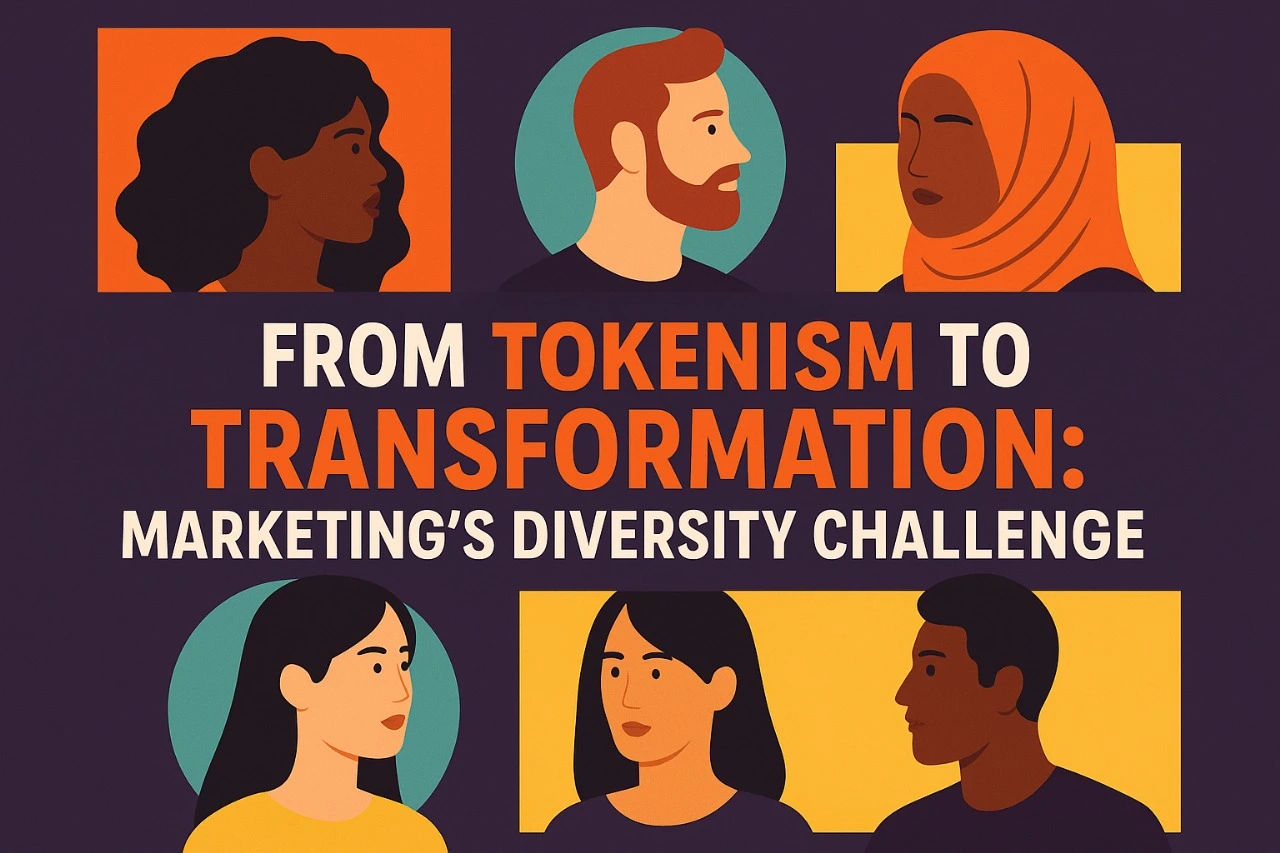
From Tokenism to Transformation: Marketing’s Diversity Challenge
admin
- 0
Why This Conversation Can’t Wait Anymore
Remember when ads just had to be funny or catchy? A quick laugh, a slick jingle, good enough. But something’s shifted. People don’t just want to be entertained anymore. They want to be seen.
Think about it: when was the last time you scrolled past an ad and thought, “That could be me”? Or worse, “They don’t even know people like me exist”?
It’s not just about wanting a seat at the table anymore. It’s about refusing to be an afterthought. Consumers, real people, from all walks of life, are saying loud and clear: “Show the world as it actually is.” Not just one kind of face, one kind of body, one kind of story. Not as a token gesture, not as a trend. But because it’s real.
This didn’t happen overnight. Movements like Black Lives Matter and #MeToo forced us all to look in the mirror. Mental health advocacy, disability awareness, LGBTQ+ rights, people are done waiting for permission to demand better. And brands? They’re being called out when they get it wrong and celebrated when they get it right.
Here’s the thing: marketing isn’t just about selling stuff. It’s about storytelling, and stories shape how we see ourselves. When ads only show one narrow version of beauty, success, or happiness, it tells everyone else: “This isn’t for you.”
But when a campaign actually reflect the messy, beautiful diversity of real life? That’s powerful. It says: “You belong here.”
So yeah, this moment matters. Not for brownie points or PR stunts, but because people are tired of being invisible. And brands have a choice:
Keep selling the same old fantasy?
Or stand for something real?
The world’s watching. What’s your answer?
How Real Change Is Happening (And Why It Matters)
The good news? Some brands are finally moving beyond performative allyship. We all remember the empty gestures, the black squares on Instagram, the rainbow-washed logos in June that disappeared come July. Consumers aren’t fooled anymore. They want substance, not symbolism.
What does real progress look like?
- •Nike didn’t just feature Colin Kaepernick in an ad; they backed him when it cost them.
- •Dove keeps challenging beauty stereotypes because it’s in their DNA, not just their marketing calendar.
- •Ben & Jerry’s treats social justice like a flavor ingredient baked into everything they do.
But here’s what’s more exciting: it’s not just the usual suspects. Behind the scenes, something bigger is shifting:
- •Unilever isn’t just tweaking ads, they’re rebuilding their entire creative process to eliminate stereotypes
- •Netflix and Spotify are investing in creators from marginalized communities, not as charity, but because diversity makes better content
- •P&G is holding their agencies accountable with hard questions about who’s actually making the work
The change isn’t just corporate, it’s personal. I’ve sat in rooms where CMOs admit: “We didn’t see what we were missing until…”
- •Until they hired their first disabled creative director
- •Until they brought community advisors into campaign development
- •Until they saw how their “aspirational” imagery made real people feel excluded
Some brands are nailing it. Others are awkwardly learning in public. But the mindset shift is clear: from fear (“What if we get canceled?”) to commitment (“How can we do better?”).
Here’s the truth your audience knows:
👉 Real inclusion isn’t a campaign. It’s who you are when no one’s watching.
Are your diversity efforts skin-deep or built into your company’s bones? That’s the difference between being relevant today and obsolete tomorrow.
The Proof is in the Numbers: Why Inclusive Marketing Isn’t Just Nice—It’s Necessary
We all know diversity should matter, but for marketers, the real power of inclusion isn’t just in principles. It’s in the results.
And the data speaks for itself.
A 2021 Deloitte study revealed something telling: 57% of consumers stick with brands that actively address social inequities, not just in words, but in action. That loyalty isn’t just warm feelings; it translates to real revenue. And it’s not just about ethics, it’s about performance. McKinsey found that companies with diverse leadership are 36% more likely to be profitable than their less inclusive competitors.
But the impact goes even deeper. Google and The Female Quotient discovered that 64% of consumers take action after seeing an inclusive ad, whether that’s buying a product, researching the brand, or even just talking about it with friends.
This isn’t about performative diversity checking boxes to avoid criticism. It’s about real connection. And that connection? It moves people.
Because today’s consumers? They’re watching. They notice who’s represented and who’s missing. They remember how brands show up (or stay silent) when it matters. They care if a company’s leadership and messaging actually reflect the world they live in.
Inclusive marketing the kind that embraces different cultures, identities, abilities, and experiences, isn’t just the right thing to do. It’s the smart thing.
So when brands commit to inclusion, it’s not about avoiding backlash. It’s about staying relevant. Building trust. Being seen.
Because when people recognize themselves in a brand’s story—when they feel valued, not just targeted they don’t just buy. They believe. And that’s where true loyalty begins.
It’s Messy And That’s the Point
Let’s be honest: Nailing diversity and inclusion in marketing isn’t simple.
Even with the best intentions, brands trip up. Maybe a campaign lands awkwardly. Maybe the “diverse” casting feels forced, like a quota, not real representation. Or worse maybe the effort rings hollow, all talk and no real action behind the scenes.
So why does this keep happening?
Because true inclusion isn’t clean. It’s uncomfortable. It demands asking hard questions, like:
Who’s actually in the room when decisions get made?
Are we amplifying diverse voices or just borrowing them for optics?
Are we open to criticism, not just defensiveness?
And yeah, fear plays a role. Brands worry about backlash for saying the wrong thing or taking a stand that backfires. But here’s the reality: silence is riskier. Consumers can spot authenticity from a mile away and they know when a brand is just playing it safe.
But here’s the good news:
👉 Nobody expects perfection. What people do expect? Effort.
A willingness to listen, learn, and evolve
Some of the most powerful brand turnarounds have come after a mistake when a company owned its blind spots and took real steps to improve. That kind of honesty? It builds trust.Because inclusive marketing isn’t a one-time campaign. It’s a practice. And like any practice, it takes work, humility, and the courage to keep trying, even when it’s hard.
Beyond Checkboxes: How to Do Inclusive Marketing Right
Let’s cut through the noise, real inclusion in marketing isn’t about slapping diversity on a billboard and calling it a day. It’s deeper than that.
So, how do brands actually walk the talk?
It starts inside. The most authentic campaigns don’t manufacture diversity, they reflect it, because the teams behind them are diverse, too. When the people shaping the message come from different lived experiences, the work resonates without feeling forced.
Here’s what truly inclusive brands are doing differently:
➤They Build Teams That Actually Represent the World
- •Hiring isn’t just about filling quotas; it’s about filling creative gaps. Diverse strategists, writers, directors, and designers bring perspectives that homogeneous teams miss.
- •It’s not just who’s in front of the camera, it’s who’s behind it.
➤They Tell Stories, Not Stereotypes
- •Inclusive marketing doesn’t just show diversity it centers real people. No tokenism, no tired tropes. Just human stories with depth.
- •They let communities speak in their own voices, not force them into a brand-approved mold.
➤They Audit Everything—Not Just Ads
- •From website copy to packaging, they check for blind spots:
- –Is the language inclusive?
- –Are images representing people authentically?
- –Is the content accessible to people with disabilities?
- •They ask: Could this alienate someone? And then they fix it.
➤They Listen Before They Create
- •Instead of assuming, they ask. Advisory boards, community partnerships, and focus groups made up of the people they’re portraying.
- •They don’t just market to people, they learn from them.
➤They Make Inclusion a Habit, Not a Holiday
- •No more “diversity month” gimmicks. Real inclusion isn’t seasonal, it’s baked into every campaign, every touchpoint, all year.
- •They don’t just market to people, they learn from them.
The Bottom Line?
This isn’t about being politically correct. It’s about being human. When people see themselves reflected, not as an afterthought, but with respect, they don’t just buy. They belong.
And that’s how brands stop chasing trends and start building real trust.
The Future of Marketing Isn’t Diverse, It’s Just Honest
Let’s be clear: This isn’t a trend. It’s not a corporate initiative or a PR strategy. What we’re seeing is bigger, a fundamental change in how brands communicate, who shapes those messages, and whose stories matter.
Marketing today isn’t just about selling; it’s about showing up.
And leaders have a choice:
- •Stick to the same old, safe-but-stale approach, or
- •Step into the discomfort, lead with empathy, and actually listen, not because it’s expected, but because it’s essential.
Here’s the thing: When inclusion is done right, it doesn’t feel like marketing. It feels like recognition. Like respect. It’s not about virtue signaling, it’s about human connection.
And in a world where consumers demand authenticity, brands can’t just mirror society anymore. They need to help rewrite it.
So to every creative, strategist, and decision-maker reading this:
Ask yourself—
Are we adding diversity to our campaigns because it’s expected… or because it’s real?
If the answer isn’t the latter, it’s time to dig deeper.
Frequently Asked Questions
Q1: What’s the difference between tokenism and authentic inclusive marketing?
Tokenism is a superficial, checkbox approach where diversity is added as an afterthought (e.g., one person of color in a large group). Authentic inclusive marketing is built from the inside out, with diverse teams telling human-centered stories that reflect the world as it is, not as a stereotype.
Q2: Isn’t inclusive marketing just a passing trend?
No. The data shows it’s a business imperative. Consumers increasingly expect and reward brands that represent them authentically. As society becomes more aware of social issues, marketing that ignores diversity will become obsolete. It’s a fundamental shift in consumer expectations.
Q3: We’re afraid of getting it wrong and facing backlash. What should we do?
Perfection isn’t the goal; progress is. The biggest risk is silence. Start by listening, building diverse teams, and being open to feedback. When you make a mistake, own it, apologize sincerely, and demonstrate a commitment to learning and doing better. Consumers respect honest effort over safe inaction.
Q4: How can we start implementing inclusive marketing practices?
Begin internally by auditing your team composition and creative process. Then, look at your content: who is represented and how? Establish community advisory boards, invest in training, and make inclusivity a year-round habit embedded in your strategy, not a one-off campaign.
Q5: Does inclusive marketing really impact the bottom line?
Yes. Studies from Deloitte, McKinsey, and Google consistently show that inclusive companies and campaigns see higher profitability, consumer loyalty, and brand trust. It’s not just an ethical choice; it’s a smart business strategy that connects with a broader audience.
The best brands don’t just speak to audiences. They stand beside them. And that’s how movements begin.


